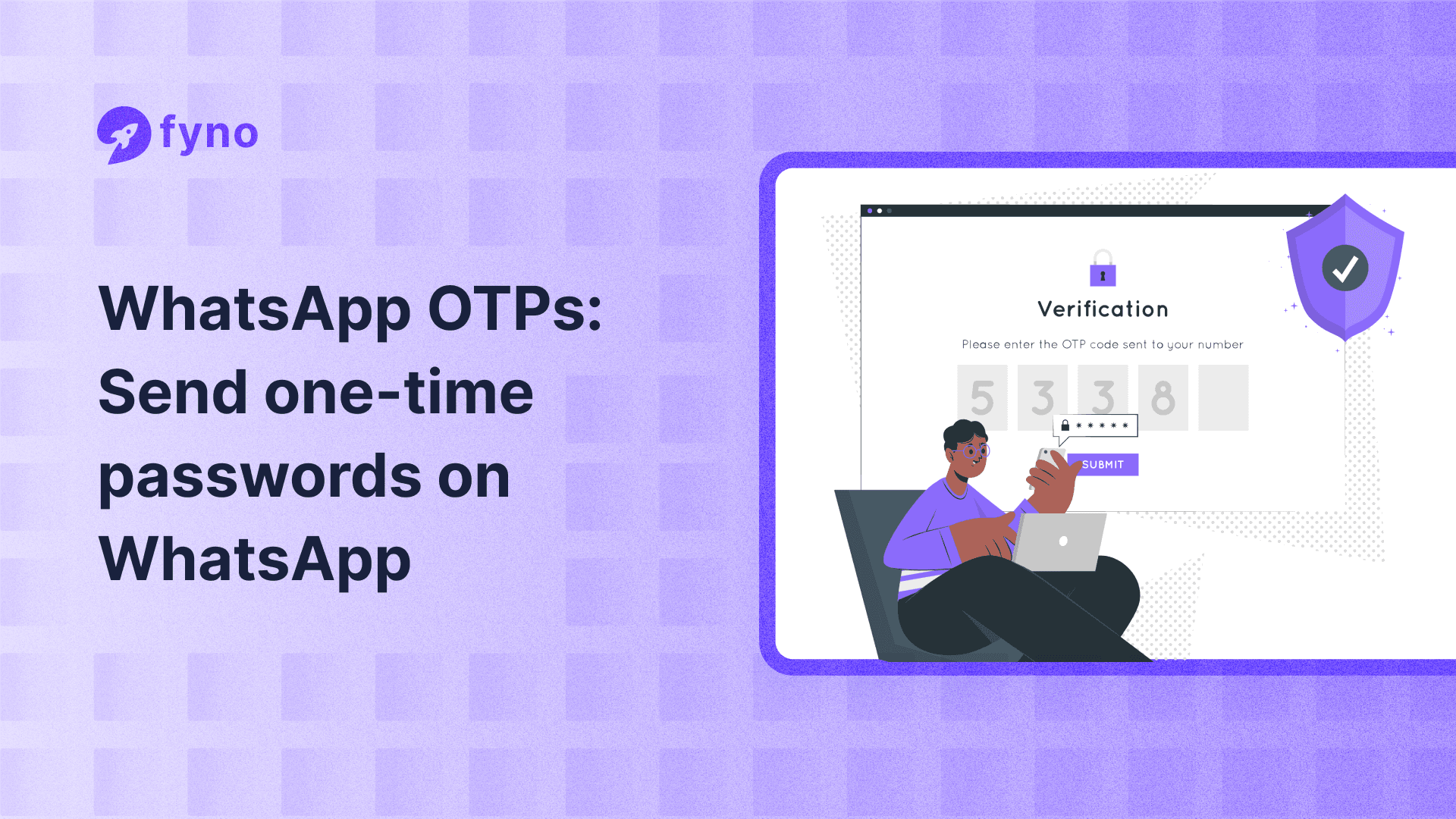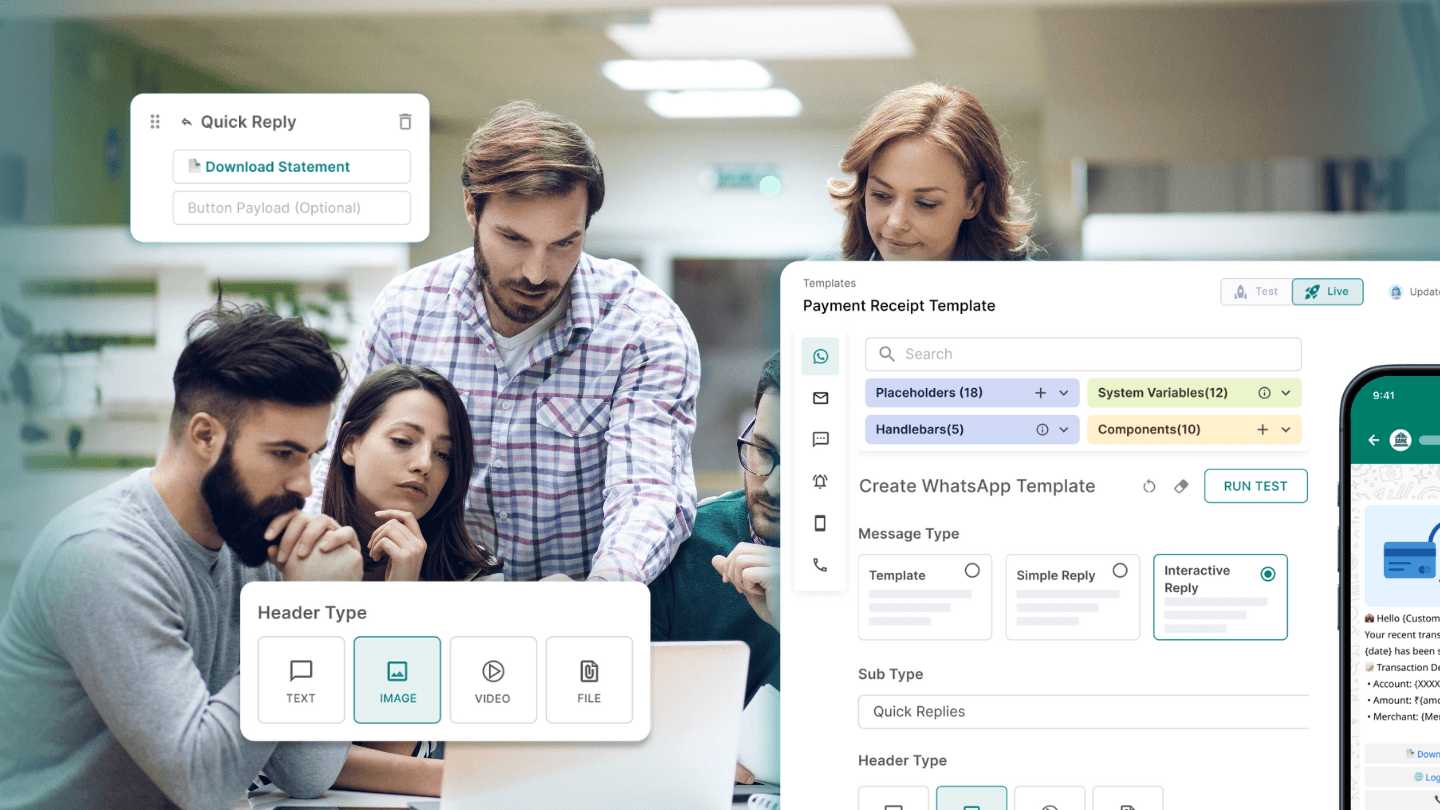For years, businesses have relied on SMS to deliver One-Time Passwords (OTPs) but that's quickly changing. More and more companies are turning to WhatsApp OTPs, and for good reason. With over 50 million businesses using WhatsApp, the shift is hard to ignore. But why the sudden move?
The answer is simple: security and user experience. While SMS OTPs are functional, they’re vulnerable to SIM swapping, interception, and delays. WhatsApp, on the other hand, brings encryption, faster delivery, and a platform most users already engage with daily.
The need for better security has never been clearer, especially after major breaches like the 2019 Twitter hack, which exposed the risks of relying solely on SMS for 2FA. Many reputable brands that prioritise security have already started using WhatsApp for OTPs.
So, is it time for your business to switch to WhatsApp OTPs? Let’s dive into the reasons why this growing trend is more than just a fad.

Introduction to OTP authentication
So, what exactly is an OTP? Standing for One-Time Password, this is a unique set of characters valid for only one login session or transaction. This temporary and dynamic nature of OTPs makes them less susceptible to theft and misuse. In the BFSI sector, where transactions need secure yet swift validation, OTPs provide that necessary layer of security without causing significant delays.
OTPs serve a crucial role in multi-factor authentication (MFA) systems, adding an extra layer of security that goes beyond just a username and password. Imagine logging into a banking app; first, you enter your password, and then you're prompted to input an OTP sent to your phone. This method combines something you know (your password) with something you have (your phone), significantly reducing the risk of unauthorized access.
Types of OTPs (HOTP, TOTP)
When discussing One-Time Passwords (OTPs), two primary types are commonly used across various industries:
- Time-based OTPs (TOTP) rely on a constant, time-related variable to generate authentication codes. This method ensures that each OTP is only valid for a short period, typically 30 to 60 seconds, enhancing security by minimizing the window for potential misuse. TOTP is widely appreciated in sectors like banking and financial services, where security cannot be compromised.
- On the other hand, HMAC-based OTPs (HOTP) are generated based on a counter mechanism that increases each time an OTP is used. This type is more user-friendly because it does not impose a time limit for the user to input the code, reducing pressure and potential errors during the authentication process.
While TOTP is generally considered more secure due to its transient nature, HOTP remains popular for its user-centric approach. Both methods ensure robust security, but the choice hinges on specific business needs and operational contexts.
Common OTP delivery methods
Delivering OTPs can be done through various channels, each with its own set of advantages. The most common methods include:
- SMS/Text: Widely used due to its simplicity and broad accessibility. However, SMS OTPs can be intercepted, which is a significant concern for sectors like banking and finance.
- Email: Another common method, offering convenience but susceptible to phishing attacks.
- Messaging apps: Apps like WhatsApp offer end-to-end encryption, making them a secure choice for delivering OTPs.
- Hardware keys: These devices generate OTPs and are immune to remote hacking attempts, providing an extra layer of security for sensitive operations.
- Authenticator apps: Apps like Google Authenticator or Authy generate TOTP codes and do not rely on network connectivity, offering a secure and reliable method for OTP delivery.
HOTP vs. TOTP: Which does WhatsApp use?
TOTP is more prevalent in everyday applications, including WhatsApp, because of its dynamic nature; it generates a new password at fixed intervals, ensuring a higher security level by reducing the window of opportunity for unauthorized access. In contrast, HOTP remains valid until it's used, making it less ideal for high-volume or time-sensitive environments.
Primarily, WhatsApp opts for TOTP due to its time-sensitive nature, aligning better with the rapid pace of digital communications. This method relies on a combination of a secret key and the current timestamp, hashed with a cryptographic function to produce a unique OTP every 30 seconds. This system not only enhances security but also simplifies the user experience by minimizing the authentication time.
Delivering OTPs securely and efficiently requires a robust system. Here’s how WhatsApp manages the delivery process:
Steps to send OTP via WhatsApp
- Initiate the process: When a user opts for authentication via WhatsApp, the service triggers the OTP generation based on the pre-established secret and the current time.
- Generate the OTP: A TOTP is generated, employing cryptographic algorithms to ensure that each password is unique and secure.
- Send the OTP: The OTP is then sent to the user’s WhatsApp, taking advantage of the platform's end-to-end encryption.
Benefits of using WhatsApp for OTPs
- Better security: By leveraging end-to-end encryption, WhatsApp ensures that OTPs remain confidential between the sender and the recipient. This encryption makes it exceedingly difficult for scammers and cybercriminals to intercept or manipulate the content, unlike SMS OTPs.
- Ease of use: Users receive their one-time passwords directly in their WhatsApp messages, which are already a part of their daily communication habits. This seamless integration eliminates the need to remember complex passwords or carry additional hardware tokens.
- Global reach: With over two billion active users worldwide, WhatsApp provides an unparalleled platform for effortlessly reaching international customers.
By integrating WhatsApp OTPs, companies can leverage these benefits to enhance security, streamline user experience, and expand their global footprint—all of which contribute to a more secure, efficient, and user-friendly authentication process.
WhatsApp OTPs vs. Traditional SMS OTPs
One-Time Passwords (OTPs) sent via WhatsApp offer several distinct advantages over traditional SMS-based OTPs. Firstly, WhatsApp account OTPs benefit from end-to-end encryption. This means that only the sender and receiver can view the message contents, safeguarding your data from potential intercepts during transmission. In contrast, SMS messages are transmitted in plain text and can be more easily intercepted by unauthorized parties.
Factors | SMS OTP | WhatsApp OTP |
Security | No encryption, vulnerable to SIM swapping and interception | End-to-end encryption, minimizing risk of interception and fraud |
Delivery Speed | Dependent on mobile network, can be delayed in poor coverage areas | Instant delivery over Wi-Fi or data, less reliant on mobile coverage |
Global Reach | Available to virtually all mobile devices, even without internet | Requires an internet connection (Wi-Fi or mobile data) |
User Experience | Simple, straightforward, limited to text | Interactive, supports rich media (images, buttons, voice, etc.), more engaging |
Cost-Effectiveness | Costs can be higher, especially for international messages | Generally lower costs, especially for high-volume messaging |
Message Length | Limited to 160 characters | Supports up to 4096 characters, enabling more detailed messages |
Spam Filtering | Can be filtered by carriers, leading to missed messages | Less prone to filtering, more likely to reach users |
Engagement Rate | Medium, SMS can be ignored or delayed | High, users tend to check WhatsApp more frequently |
Branding Opportunities | Limited, text-based messages only | Verified business profiles with branding elements like logos |
Two-Way Communication | One-way communication; no real-time interaction | Supports real-time two-way interaction, improving user experience |
Authentication Templates | Basic, no pre-built templates | Customizable authentication templates (e.g., one-tap, zero-tap) |
Why WhatsApp OTP is more secure than SMS OTP?
WhatsApp's enhanced security is its end-to-end encryption, ensuring that messages are protected from potential eavesdropping, phishing attempts, and man-in-the-middle attacks.
For instance, when a bank sends an OTP to a client for transaction approval via WhatsApp, the encrypted message adds an extra layer of security compared to the traditional SMS. This reduces the risk of fraudulent activities, providing customers with peace of mind that their transactions are protected.
Moreover, WhatsApp's structure allows for an additional layer of security settings, such as two-step verification and in-app locks, which aren't typically available with standard SMS services.
Implementing WhatsApp OTP with business systems
Setting up a WhatsApp Business account to deliver OTPs involves several key steps:
- Verify the business account: Ensuring the business is authenticated by WhatsApp adds a layer of trust and security.
- Integrate APIs: Businesses need to integrate the WhatsApp Business API, which allows for automated messaging, including OTPs.
- Configure message templates: WhatsApp requires businesses to pre-define message templates for OTPs, which helps streamline the process and ensure compliance with WhatsApp’s policies.
Another option is to configure your WhatsApp business account to work with a third-party service. This could be an authentication server or another messaging platform, depending on what suits your business model best.
With Fyno, a business can activate its Meta verified WhatsApp Business account in just less than 20 minutes.Learn more.
Popular Use Cases for WhatsApp OTPs
- User registration
- Transaction confirmations
- Password Reset
- Two-factor Authentication (2FA)
Best Practices for WhatsApp OTP
Implementing WhatsApp OTP effectively requires adhering to several best practices to enhance security and user experience:
- Verify user numbers: Ensure that OTPs are sent only to verified WhatsApp account numbers. This practice helps prevent unauthorized access and potential security breaches.
- Clear communication on OTP expiry: Inform your users about the OTP’s validity period to manage expectations and reduce potential frustrations that might arise from expired codes.
- Robust monitoring and logging: Keep track of OTP transmissions and access attempts. This not only helps in identifying and rectifying issues promptly but also enhances the security by detecting and mitigating potential threats.
- Leverage automation: Automate the OTP generation and delivery processes to ensure immediate transmission and improve efficiency. However, ensure that this automation does not compromise the user experience and compliance.
- Enhance brand visibility: Use WhatsApp OTP messages as an opportunity to reinforce your brand by incorporating your name and logo.
Common mistakes to avoid
Avoid common pitfalls that could undermine the effectiveness of your WhatsApp OTP strategy:
- Neglecting user privacy: Always ensure that user data is handled with the highest standards of privacy and security, especially when transmitting sensitive information like OTPs.
- Inadequate testing: Before rolling out the WhatsApp OTP feature, conduct thorough testing to ensure everything works as intended. This includes testing under different scenarios to identify potential failures or security loopholes.
- Ignoring user feedback: Pay attention to what users say about their experience with your OTP system to make continuous improvements.
- Failing to update security measures: As technology evolves, so do the tactics employed by cybercriminals. Regularly update your security protocols to safeguard against new threats. Or work with a reliable customer notification system that can handle all the compliances on your behalf.
Conclusion
By choosing WhatsApp OTPs, businesses are not only enhancing security but also improving user experience with faster, encrypted deliveries. With end-to-end encryption and seamless API integration, Fyno ensures that your authentication processes are both secure and scalable, reducing vulnerabilities and risks, especially SMS spoofing, SMS phishing, and SMS interception.
Recommended Read: SMS Security - Risks, Benefits, and Solutions for 2FA
So, are you ready to elevate your business security and communication with a Meta tech partner like Fyno? Let Fyno help you unlock the full potential of WhatsApp for your enterprise today.


